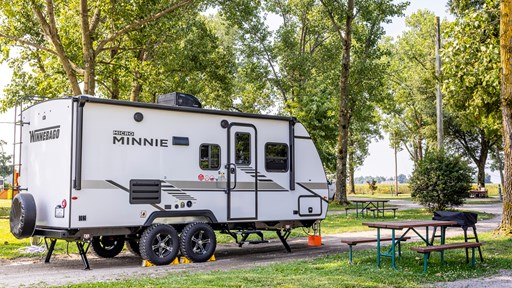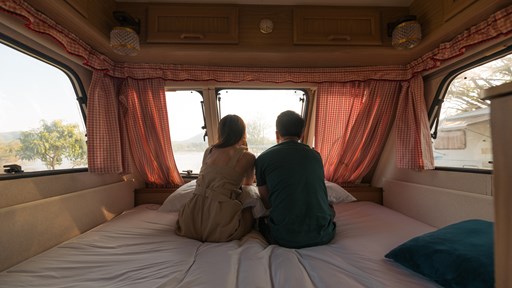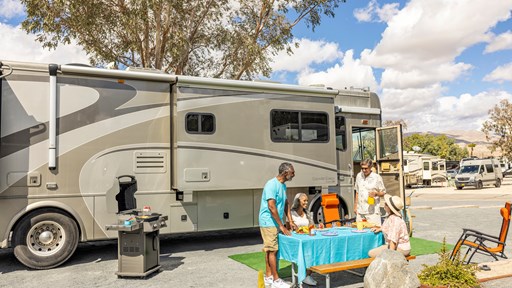America’s national park system hosts every type of ecosystem you can think of—from the stark Mojave Desert to the lush rainforests of the Pacific Coast—and wonderful ways to enjoy them, from hiking to biking to simply watching the sunset. And, with an RV, you can roll right up and make your home base in the park itself, without having to shuttle back and forth, and with all the comforts of home right there with you.
It’s important to remember, however, that National Park Service-hosted sites won’t have some of the amenities and hookups RV travelers might be accustomed to at private campgrounds. But that doesn’t mean you shouldn’t go: In fact, this kind of trip is a great opportunity to refresh your dry camping skills, wake up to some of the most spectacular scenery on the continent, and have an adventure you’ll remember for the rest of your life. It just takes some additional planning and prep. Another option is to choose a campground in close proximity to the park for at least part of your trip. There you can find additional amenities and often fewer crowds. KOA has campgrounds near almost every national park (and sometimes several to choose from) that can make an RV trip easier and more enjoyable.
To make the most of your experience, here are some insider tips that will make your national park RV trip a smooth ride.
1. Choose a Park With Wide, Navigable Roads

Getting your RV to your national park destination is simple—as long as you map your route carefully. Once you’re there, the trick is to make sure travel within the park is as easy as possible—navigating a rig along through hairpin turns or over unexpectedly bumpy terrain isn’t exactly what fun camping vacations are made of. Advance planning will help you avoid getting stuck on a challenging route or road, and choosing an accessible park will make everything simpler from the get-go. Looking for some possible options to get started? State Route 190 runs right through Death Valley National Park, and Rocky Mountain National Park has wide roads and scenic drives perfect for RV travel.
2. Reserve Your Campsite Well in Advance (and Know the Regulations)
Campsites with full RV hookups can be tough to come by in U.S. national parks, and especially challenging to reserve once the season gets into full swing. As soon as you know your travel dates, start looking for campsites with RV hookups (Colter Bay RV Park in Grand Teton National Park, which allows RVs and campers only, no tents, is a good example), and be sure to note size limitations at different locations. Keep in mind that some places have generator restrictions depending on the time of day.
3. Stay Up-to-Date on Road Closures
Road closures outside and within park boundaries can throw a wrench into the best-laid plans, taking you way off course. Even though the most mind-bending detour can be eventually navigated, knowing about closures in advance will prevent navigation headaches and the inevitable stress that comes with driving a large rig on unfamiliar roads. Check message boards at the official NPS site for each park (like this page for Great Smoky Mountains National Park). In addition, driving apps like Waze maintain an up-to-date database of road closures and hazardous driving conditions.
4. Stay on Budget

Stocking up on groceries and fueling up before you reach the park is the best thing you can do for your travel budget, as gas and supplies cost a premium once you arrive within the park boundaries. You’ll be able to buy necessities at park stores if you run out of essentials like toothpaste or coffee, but do your big food run long before reaching the park. The same goes for fueling the RV and any other vehicles. Gas prices are significantly higher the closer you get to the park (and astronomical within it), so be sure to arrive with a full tank.
5. Be Prepared to Dry Camp
Full hookups are limited in the national park system, but this doesn’t mean you can’t camp and enjoy the benefits of being close to nature. Be prepared to dry camp, and take the family on a few practice runs beforehand. RV campsites at national parks are in some of the most scenic areas of the country, and the lack of hookups is in place for a reason: Less impact on the surrounding environment is something we can all get behind.
6. Keep Your Site Clean and Store Food Properly
Because of high levels of wildlife activity (especially bears), national parks often provide campers with required bear lockers or other wildlife-proof storage. Some parks ask that food (and, in some cases, any scented toiletries like toothpaste and deodorant) not be stored in vehicles, as the more intrepid bears have been known to get into locked cars to get at food.
In addition, be sure to always clean up your outdoor cooking site, and never leave leftovers outside. Doing otherwise isn’t just disrespectful to fellow campers; it has serious negative consequences for wildlife, and can sometimes result in removal or euthanization. Instead, if you’re looking to check “bear sighting” off your list while being a responsible national park visitor, consider taking the RV out to Shenandoah National Park or Denali National Park—both offer excellent chances of seeing one of these majestic creatures.
Written by Matcha for Kampgrounds of America.


























